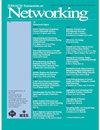Throughput Analysis for Parallel Decoding of Irregular Repetition Slotted ALOHA With Noise
IF 3
3区 计算机科学
Q2 COMPUTER SCIENCE, HARDWARE & ARCHITECTURE
引用次数: 0
Abstract
Due to its simplicity and scalability, the Irregular Repetition Slotted ALOHA (IRSA) system that uses the successive interference cancellation (SIC) technique is a promising solution for uncoordinated multiple access of a massive number of Internet-of-Things (IoT) devices. In this paper, we propose two parallel decoding algorithms for IRSA in an additive white Gaussian noise channel. Our first algorithm is limited to SIC-decoupling matrices that correspond to the SIC decoding process in IRSA. For this, we propose a message-passing algorithm to find the optimal SIC-decoupling matrix that can minimize the accumulated noise power when the induced user-slot bipartite graph of an IRSA system is acyclic. This includes the Contention Resolution Diversity Slotted ALOHA (CRDSA) system that sends exactly two copies for each packet as a special case. Our second algorithm extends the first one by finding the optimal decoupling matrix for CRDSA through an optimal combination of two SIC-decoupling matrices. Using a random graph analysis, we derive the throughput for the two parallel decoding algorithms of CRDSA in a threshold-based decoding model. We then conduct various numerical experiments to illustrate the tradeoffs between sequential decoding with a limited number of iterations and parallel decoding with a predefined signal-to-noise ratio (SNR) threshold. Finally, we demonstrate how to extend our parallel decoding scheme to bipartite graphs with cycles.有噪声的不规则重复开槽 ALOHA 并行解码吞吐量分析
由于其简单性和可扩展性,使用连续干扰消除(SIC)技术的不规则重复开槽 ALOHA(IRSA)系统是大量物联网(IoT)设备非协调多路接入的一种有前途的解决方案。本文针对加性白高斯噪声信道中的 IRSA 提出了两种并行解码算法。我们的第一种算法仅限于与 IRSA 中 SIC 解码过程相对应的 SIC 解耦矩阵。为此,我们提出了一种消息传递算法,用于寻找最优 SIC 解耦矩阵,当 IRSA 系统的诱导用户时隙双方图为非循环图时,该矩阵可使累积噪声功率最小。这包括竞争解决分集槽式 ALOHA(CRDSA)系统,该系统作为一种特例,每个数据包正好发送两份拷贝。我们的第二种算法扩展了第一种算法,通过两个 SIC 解耦矩阵的优化组合,找到了 CRDSA 的最佳解耦矩阵。通过随机图分析,我们得出了基于阈值的解码模型中 CRDSA 两种并行解码算法的吞吐量。然后,我们进行了各种数值实验,以说明有限迭代次数的顺序解码与预定义信噪比 (SNR) 门限的并行解码之间的权衡。最后,我们演示了如何将并行解码方案扩展到具有循环的双方图。
本文章由计算机程序翻译,如有差异,请以英文原文为准。
求助全文
约1分钟内获得全文
求助全文
来源期刊

IEEE/ACM Transactions on Networking
工程技术-电信学
CiteScore
8.20
自引率
5.40%
发文量
246
审稿时长
4-8 weeks
期刊介绍:
The IEEE/ACM Transactions on Networking’s high-level objective is to publish high-quality, original research results derived from theoretical or experimental exploration of the area of communication/computer networking, covering all sorts of information transport networks over all sorts of physical layer technologies, both wireline (all kinds of guided media: e.g., copper, optical) and wireless (e.g., radio-frequency, acoustic (e.g., underwater), infra-red), or hybrids of these. The journal welcomes applied contributions reporting on novel experiences and experiments with actual systems.
 求助内容:
求助内容: 应助结果提醒方式:
应助结果提醒方式:


